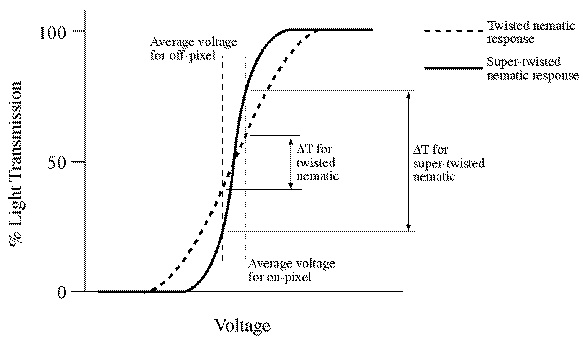


Next: ``Active Addressing'' LCDs
Up: Improving passive matrix
Previous: Improving passive matrix
Twisted nematic displays rotate the director of the liquid crystal by
 , but super-twisted nematic displays employ up to a
, but super-twisted nematic displays employ up to a
 rotation. This extra rotation gives the crystal a much
steeper voltage-brightness response curve and also widens the angle at
which the display can be viewed before losing much contrast. With the
sharper response, it is possible to achieve higher contrast with the
same voltage selection ratio. Therefore, the degree to which
multiplexing is possible is greatly increased. The largest common
super-twist displays have up to 500 rows.
rotation. This extra rotation gives the crystal a much
steeper voltage-brightness response curve and also widens the angle at
which the display can be viewed before losing much contrast. With the
sharper response, it is possible to achieve higher contrast with the
same voltage selection ratio. Therefore, the degree to which
multiplexing is possible is greatly increased. The largest common
super-twist displays have up to 500 rows.

Figure 4: Response curve of a super-twisted nematic LCD compared
with the response of an ordinary twisted nematic LCD. The
steeper response exhibited by the super-twist display makes a
wider range of brightness possible.
In dual-scan super-twist displays, two essentially separate
displays are placed adjacent to each other and scanned simultaneously
by separate electronics. This cuts the number of rows in each part by
half. The reduced multiplexing in each half means higher selection
ratios and consequently, even better contrast. In a double-cell
super-twist display, there are two cells on top of each other with
helical directions opposite each other. Since the circular
birefringence is wavelength dependent, this provides a way to undo the
wavelength disturbance created when passing through only one layer,
thereby providing slightly improved contrast and a true black and
white display.
Stefan Agamanolis
Thu May 18 11:00:12 EDT 1995
 , but super-twisted nematic displays employ up to a
, but super-twisted nematic displays employ up to a
 rotation. This extra rotation gives the crystal a much
steeper voltage-brightness response curve and also widens the angle at
which the display can be viewed before losing much contrast. With the
sharper response, it is possible to achieve higher contrast with the
same voltage selection ratio. Therefore, the degree to which
multiplexing is possible is greatly increased. The largest common
super-twist displays have up to 500 rows.
rotation. This extra rotation gives the crystal a much
steeper voltage-brightness response curve and also widens the angle at
which the display can be viewed before losing much contrast. With the
sharper response, it is possible to achieve higher contrast with the
same voltage selection ratio. Therefore, the degree to which
multiplexing is possible is greatly increased. The largest common
super-twist displays have up to 500 rows.



